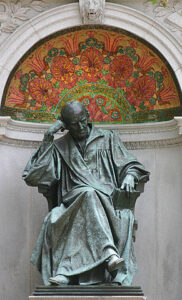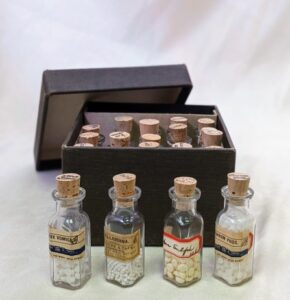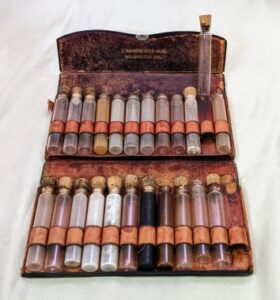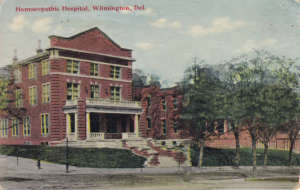Homeopathy: The Art of Making Nothing Out of Something
by Sharon Folkenroth-Hess, M.A.

Samuel Hahnemann (1755-1843) studied chemistry and metallurgy before receiving his medical degree at the University of Erlangen in Bavaria in 1779. Hahnemann took a position as a village doctor in Mansfeld, Saxony. It was not long until he started to question the efficacy of modern medicine and was increasingly concerned with the harm that often resulted from the standard treatment methods of the day. Humorism, or heroic depletion theory, as it is also known, was the prevailing medical concept in Europe into the 18th and early 19th centuries. According to this theory, imbalances in bodily substances or “humors” cause disease. Balancing a patient’s humors (black and yellow bile, phlegm, and blood) would help the patient reach homeostasis, thereby curing the malady. Symptoms were not considered the body’s attempt to fight the disease but were a complication that worsened the patient’s condition. Intensive bloodletting, purging, blistering, and sweating were needed to shock the humors back into balance. Drugs (including mercury, arsenic, and lead) were administered in high doses to achieve dramatic results.
Often the cure was worse than the disease. Dr. Hahnemann described “modern medicine” in his treatise The Chronic Diseases: Their Peculiar Nature and Their Homeopathic Cure (1):
“Treatment by allopathic physicians hitherto merely served to increase the distress from…disease; for this treatment consisted of a whole multitude of nauseous mixtures (compounded by the druggist from violently acting medicines in large doses, of whose separate true effects they were ignorant), together with the use of manifold baths, the sudorific [sweat-inducing] and salivating remedies, the pain-killing narcotics, the injections, fomentations, fumigations, the blistering plasters, the exutories and fontanels (2), but especially the everlasting laxatives, leeches, cuppings and starving treatments, or whatever names may be given to all these medicinal torments, which continually varied like the fashions: By these means the disease was either aggravated and the vital force, [in] spite of so-called tonics used at intervals, was more and more diminished; or, if any striking change was produced by them, instead of the former sufferings, there appeared a worse state – nameless diseases caused by medicine, far worse and more incurable than the original natural one-while the physician consoled the patient with the words: “The former sickness I have been fortunate enough to remove; it is a great pity that a new disease has appeared, but I hope to be as successful in removing [as well].”
Hahnemann soon withdrew from his practice and spent his days translating medical and scientific works. During his work as a translator, Hahnemann began to form his theories that eventually became homeopathy.

Artist: Ward Briggs
Gift of J. Robert Lennon
1985.8.1
In William Cullen’s (1710-1790) Lectures on the Materia Medical (1772), he proposed that cinchona (a tropical shrub containing quinine) could cure malaria. Hahnemann was skeptical of this claim and decided to ingest some bark to see what would happen. He reported experiencing fever, chills, and joint pain, all symptoms like those of malaria. Hahnemann deduced that all drugs that can produce a set of symptoms in a healthy individual could treat a sick individual who is manifesting a similar set of symptoms. Hahnemann developed the central principle of homeopathy known as similia similibus curantur (like cures like) or the “law of similars.”
- Law of Similars: A substance that produces similar symptoms in healthy people can cure disease and illness.
- Law of minimum dose: more diluted medications are more effective.
To create the appropriately low dose or “homeopathic dilution,” practitioners used a process called “dynamization” or “potentisation,” in which a substance is diluted with alcohol or distilled water and then vigorously shaken in a process called “succussion.” This process, according to Hahnemann, is imperative to the manufacture of the medicine:
“Homeopathic Dynamizations are processes by which the medicinal properties, which are latent in natural substances while in their crude state, become aroused, and then become enabled to act in an almost spiritual manner on our life i.e. on our sensible and irritable fibre. This development of the properties of crude natural substances (dynamization) takes place… in the case of dry substances by means of trituration (grinding) in a mortar, but in the case of fluid substances, by means of shaking or succussion, which is also trituration. These preparations cannot be simply designated as dilutions, although every preparation of this kind, in order that it may be raised to a higher potency, in order that the medicinal properties still latent within it may be yet farther awakened and developed, must first undergo a further attenuation, in order that the trituration or succussion may enter still further into the very essence of the medicinal substance, and may thus also liberate and expose the more subtle part of the medicinal powers that lie hidden more deeply, which could not be affected by any amount of trituration and succussion of the substances in their concentrated form.”(3)


The substances destined for dynamization in homeopathic medicines are derived from plants (like red onion, poison ivy, and deadly nightshade), minerals (such as white arsenic), or animals (like crushed bees). The final dilutions are often made into sugar pellets placed under the tongue and ointments, drops, creams, and tablets. Treatments are “individualized” or tailored to each individual — often, patients with the same condition receive different treatments.
Fortunately for those of us that handle historical objects, many homeopathic medicines are so diluted that no molecules of the original substance remain, although this is not always the case. Hahnemann’s new treatments and his “law of minimum dose” were undeniably less harmful than his colleagues’ bloodletting and purging regimens. After he published Organon of the Rational Art of Healing in 1810, homeopathy spread among others dissatisfied with mainstream medicine. Homeopathic societies sprang up worldwide by the 1830s and 1840s.

Constantine Herring (1800-1880), the father of homeopathy in America, established the Hahnemannian Society of Philadelphia (1833) and later the Homeopathic Medical Society of Philadelphia (1838). In 1835, he helped found the first (albeit short-lived) homeopathic medical school in the U.S., the North American Academy of Homeopathic Medicine in Allentown, PA. Soon Philadelphia had two medical colleges, the Homeopathic Medical College of Pennsylvania (1848) and the Hahnemann Medical College (1867); the two schools merged in 1871. Dr. Herring helped disseminate Hanneman’s ideas through the publication. He created scholarly journals (American Journal of Homeopathy and Philadelphia Journal of Homeopathy) and wrote several books. His 1848 book, the Domestic Physician, became the authoritative text on the subject. ![]() The Jacob F. Sheek Homeopathy Kit (image to the right) was marketed as a companion to the book.
The Jacob F. Sheek Homeopathy Kit (image to the right) was marketed as a companion to the book.
Physicians trained in these Philadelphia medical colleges began to practice in Delaware. A committee of doctors and Wilmingtonians began fundraising to build a hospital closer to home. On February 10, 1888, the Homeopathic Hospital opened in the former Heald Hygeian Home on Van Buren Street and Shallcross Avenue. As the first hospital in Wilmington, it offered care to all, regardless of color, religion, or ability to pay. The only thing they refused was allopathic medicine. That changed in 1940 when it was renamed Memorial Hospital. The hospital was razed in 1985. 
- Hahnemann, S. (1896). The Chronic Diseases: Their Peculiar Nature and Their Homoeopathic Cure. India: C. Ringer & Company (1). The original was published in German in 1828 and translated into numerous languages.
- Exutories are artificially-made ulcers. A fontanel is a procedure in which a doctor burns a hole in the patient’s skin, inserts an irritant substance, and covers the wound with a bandage.
- Hahnemann, S. (1896). The Chronic Diseases: Their Peculiar Nature and Their Homoeopathic Cure. India: C. Ringer & Company. (1)